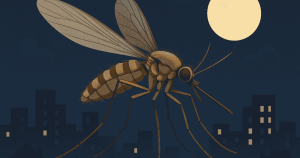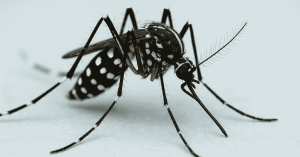Ever wondered who’s buzzing around your ears when you’re trying to sleep at night?
Chances are, it’s not the famous dengue mosquito Aedes aegypti—but Culex pipiens, the city’s very own urban night flyer.
My First Encounter with the Night Flyer
When I first moved to Jakarta for college, I had a tiny rented room with one window facing the street. Almost every night, I was woken up by the high-pitched hum of a mosquito. At first, I thought it was just “any mosquito.” But after digging deeper, I realized I was dealing with Culex pipiens—the species that thrives in cities and loves the cover of night.
That curiosity turned into research, and here’s what I found.
Meet Culex pipiens
- One of the most common mosquitoes in cities worldwide (except Antarctica).
- Comes in two “biotypes”:
- pipiens – prefers feeding on birds.
- molestus – prefers mammals, including humans.
- Sometimes they hybridize, creating a dangerous “bridge” vector that can pass diseases from birds to people.
So, when you wake up with fresh bites in the morning, don’t be surprised if this night flyer is the culprit.
Life in the City
Unlike Aedes aegypti, which loves fresh water, Culex pipiens isn’t picky. It can breed in:
- Street drains and gutters.
- Buckets or water containers left outside.
- Underground systems like subway tunnels.
In fact, scientists discovered that the molestus type has lived underground for centuries, adapting perfectly to human-made environments like London’s subway system. This flexibility is what makes Culex pipiens such a successful “urban insect.”
The Life Cycle of a Night Mosquito
Just like other mosquitoes, Culex pipiens goes through four stages:
- Eggs – laid on the surface of stagnant water, forming little rafts of 100–300 eggs.
- Larvae – wriggle around in water, feeding and growing.
- Pupae – resting stage before emerging as adults.
- Adults – fly out, mostly active at night, hunting for a meal.
In colder climates, adults can survive winter by going into diapause, a kind of mini-hibernation.
Why Should We Care? Diseases They Carry
While a mosquito bite may seem harmless, Culex pipiens is a known vector for serious diseases:
- West Nile Virus
- Usutu Virus
- Saint Louis Encephalitis
- Avian Malaria
- Filarial worms
The hybrid form—feeding on both birds and humans—makes disease spill-over more likely. That’s why this night flyer is more than just a sleep-disturbing pest.
Culex vs Other Mosquitoes
It’s easy to mix up mosquitoes, so here’s a quick comparison:
- Aedes aegypti → Active in the day, spreads dengue, chikungunya, Zika.
- Anopheles → Active dusk to dawn, main malaria vector, common in rural areas.
- Culex pipiens → Active at night, loves urban life, spreads viral encephalitis and West Nile.
How to Protect Yourself from the Night Flyer
The good news? Small changes can make a big difference.
- Remove stagnant water around your home.
- Cover buckets, water tanks, and drains.
- Use a mosquito net or repellant lotion when sleeping.
- Check gutters and ditches near your house.
These simple habits can save you from sleepless nights and itchy mornings.
FAQ
Q: Is Culex pipiens the same as Aedes aegypti?
A: No. Aedes is active during the day, while Culex pipiens hunts at night.
Q: Are all Culex pipiens dangerous?
A: Not all carry disease, but they still pose health risks.
Q: Why is it called the “night flyer”?
A: Because its peak activity happens after sunset, when people are most vulnerable while sleeping.
- Culex pipiens is the urban night flyer, thriving in cities across the world.
- Two main forms: pipiens (birds) and molestus (humans).
- Hybrids can spread diseases from birds to humans.
- Best protection: remove standing water and guard yourself at night.
After years of brushing off night-time bites as “just mosquitoes,” I’ve learned there’s more to the story. Culex pipiens isn’t just an annoyance—it’s a survivor, an adapter, and sometimes, a silent threat.
So the next time you hear that faint buzz in the middle of the night, remember: it might just be the urban night flyer keeping you company. And with a little prevention, you can make sure it stays outside your bedroom.





